|
|
|
Sort Order |
|
|
|
Items / Page
|
|
|
|
|
|
|
| Srl | Item |
| 1 |
ID:
072627


|
|
|
|
|
| Publication |
2006.
|
| Summary/Abstract |
For nearly ten years, nongovernmental actors have raised concerns about the increased accessibility of small arms and light weapons around the world. By the late 1990s, hundreds of these nongovernmental actors began to coalesce together in an effort to enhance awareness, conduct research and affect policy relevant to small arms issues. How did this NGO coalition emerge? How does it operate? How effective has it been? Where is it headed? To answer these questions we seek to assess the structure and activities of the SAM based on existing understandings of transnational social movements. We focus specifically on the emergence, structure and effectiveness of the SAM-a movement that has, according to many of its participants, founders and observers, struggled over its years of operation to achieve its objectives. Moreover, we offer a comparative analysis of the successful International Campaign to Ban Landmines in an effort to demonstrate similarities and differences in the two transnational organizations. Our findings lead to a number of recommendations we believe the SAM should heed to become more effective.
|
|
|
|
|
|
|
|
|
|
|
|
|
|
|
|
| 2 |
ID:
072629
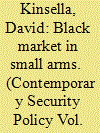

|
|
|
|
|
| Publication |
2006.
|
| Summary/Abstract |
In recent years, researchers have increasingly turned their attention to the proliferation of small arms, a transnational trade amounting to over $7 billion in value during 2002. Small arms are difficult to track and are not the stuff of military parades, but they are immensely destructive. As much as $1 billion worth enters the black market annually. I argue that the illicit trade in small arms should be understood not as a market but as a network, one that shares some important properties with networked forms of organization studied by sociologists. I then employ quantitative methods developed for the study of social networks in an effort to show the basic structure of illegal small arms transfers to Africa. The analysis draws from my Illicit Arms Transfers dataset still in development, so the results make use of the most rudimentary information being collected. They are suggestive, however, and the analytical approach promises to shed considerable light on a corner of the global arms trade that is of great interest to the research and activist communities, and of great consequence to those in war-torn regions of the world.
|
|
|
|
|
|
|
|
|
|
|
|
|
|
|
|
| 3 |
ID:
072631
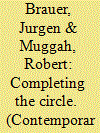

|
|
|
|
|
| Publication |
2006.
|
| Summary/Abstract |
This essay presents a theory of small arms demand and provides initial evidence from ongoing case studies in the Solomon Islands, Papua New Guinea, South Africa and Brazil. The theory revolves around the motivations and means to acquire arms, addressing issues such as contrasting acquirers and possessors and differentiating between acquirers and non-acquirers, consumers and producers, and final and intermediate demand. The essay also studies characteristics of small arms that make them so desirable as compared to other means of conducting violent conflict. The overall goal is to provide a theoretical framework and language that is common to a variety of social science approaches to the study of small arms use, misuse and abuse.
|
|
|
|
|
|
|
|
|
|
|
|
|
|
|
|
| 4 |
ID:
072635
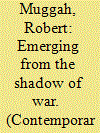

|
|
|
|
|
| Publication |
2006.
|
| Summary/Abstract |
Drawing on a wide range and multidisciplinary literature, this essay provides an overview of post-conflict armed violence. It then introduces a critical review of disarmament, demobilization and reintegration and weapons reduction activities - two comparatively new interventions championed by development donors ostensibly to reduce armed violence and secure the peace.
|
|
|
|
|
|
|
|
|
|
|
|
|
|
|
|
| 5 |
ID:
072624
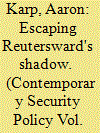

|
|
|
|
|
| Publication |
2006.
|
| Summary/Abstract |
The small arms agenda remains almost exclusively reactive, responding mostly to the needs of the states that finance small arms diplomacy and fieldwork. NGOs and research institutes, tied to government priorities, have been unable to develop an independent voice. Activists have sought influence over small arms politics instead by broadening their agenda to include related social pathologies. This strategy, pragmatic in the short term, threatens the integrity and durability of small arms activism in the long run. It has allowed small arms activism to prosper without articulating the kind of goals necessary to sustain it. Instead of clear goals, the field has been guided largely by images, including art, represented in this essay by Carl Fredrik Reuterswärd's Non-Violence. To assure its health and influence, small arms activism, research and policy requires greater control over its agenda. Instead of relying on aesthetic inspiration and the tendency to broaden its agenda, the field requires deeper engagement with core concerns. This can only come through articulation of goals to explicitly reduce the role of firearms in human affairs. The place for such action is less in the United Nations and more through national campaigns, focusing on states, the only bodies that actually own and regulate guns.
|
|
|
|
|
|
|
|
|
|
|
|
|
|
|
|
| 6 |
ID:
072632
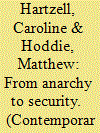

|
|
|
|
|
| Publication |
2006.
|
| Summary/Abstract |
This essay offers a critical evaluation of two contending theoretical approaches to achieving disarmament and an enduring peace following the negotiated resolution of civil war. The neorealist approach is associated with the work of Barbara Walter and suggests that third party enforcement of the terms of the peace is critical to fostering the confidence necessary for rival groups to lay down their arms and renew the process of intrastate cooperation. In contrast, we identify an alternative neoliberal approach, one that does not depend entirely on the unreliable goodwill of the international community. We suggest that former enemies have the opportunity autonomously to build the trust necessary to achieve disarmament through an agreement to create a network of power sharing and power dividing institutions.
|
|
|
|
|
|
|
|
|
|
|
|
|
|
|
|
| 7 |
ID:
072633
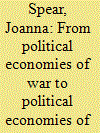

|
|
|
|
|
| Publication |
2006.
|
| Summary/Abstract |
Can disarmament, demobilization and reintegration (DDR) be a means to 'jump start' a transition to a political economy for peace? This essay considers the key groups targeted in DDR - individual fighters, middle-level officers and leaderships - and each element of a DDR campaign with a focus on political economy issues. This leads to suggestions for reorienting some elements of DDR campaigns to place more emphasis on looking after middle-ranked officers, for the international community to place much emphasis on an often under-resourced part of the process, reintegration, and for more parallel attention to dealing with illicit economic activities.
|
|
|
|
|
|
|
|
|
|
|
|
|
|
|
|
| 8 |
ID:
072623


|
|
|
| 9 |
ID:
072626
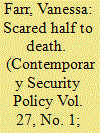

|
|
|
|
|
| Publication |
2006.
|
| Summary/Abstract |
Due to their widespread availability, mobility and ease of use, small arms are a very important factor in the flaring up and perpetration of many expressions of trauma, both in times of war and in degraded 'peacetime' environments characterized by large-scale violence. They have become central to maintaining social dislocation, destabilization, insecurity and crime in the build-up to war, in wartime and in the aftermath of conflict. Small arms are misused within domestic settings as well as in public spaces, and they impact on everyone in the community. One means to counter their effects, therefore, is to increase our understanding of the role played by prolific small arms and light weapons in reinforcing and maintaining genderspecific violence before, during and after conflict.
|
|
|
|
|
|
|
|
|
|
|
|
|
|
|
|
| 10 |
ID:
072625
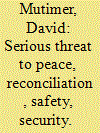

|
|
|
|
|
| Publication |
2006.
|
| Summary/Abstract |
Evaluations of the 2001 Conference on the illicit trade in Small Arms and Light Weapons and the Programme of Action (PoA) which it produced cover the gamut from success to failure. This essay does not seek to explain the success or failure of the Conference, nor does it look forward to the 2006 Conference and beyond to see what possibilities there are for global public policy on SALW. It is concerned, rather, with the topography of the issue which will come to the table in 2006. By means of Michel Foucault's notion of 'effective history', the essay investigates the problem that the PoA has produced. It shows how that problem is constituted around two key features: small arms and light weapons as a particular category of technology, and the division between the licit and illicit trade. It demonstrates both the contingency of this framing and the effects that it has produced. In particular, it shows how this framing makes possible a set of 'proliferation control' practices similar to those applied to other forms of military technology, and how it masks forms of gun violence, particularly those directed against women.
|
|
|
|
|
|
|
|
|
|
|
|
|
|
|
|
| 11 |
ID:
072628


|
|
|
|
|
| Publication |
2006.
|
| Summary/Abstract |
Since the end of the Cold War there has been a growing tendency within the arms control community to treat major conventional weapons and small arms and light weapons as separate fields of action. This essay challenges the utility of this differentiation and argues instead that effective arms control requires that the full range of conventional weapons be addressed when policy proposals are formulated.
|
|
|
|
|
|
|
|
|
|
|
|
|
|
|
|
| 12 |
ID:
072630
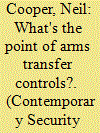

|
|
|
|
|
| Publication |
2006.
|
| Summary/Abstract |
This essay examines the contemporary architecture of conventional arms transfer restrictions and concludes that it is deficient. In part this is simply due to the absence of political will to effectively implement existing arms transfer restraint. However, it is also the case that the globalization of the defense industry, the growing employment of dual-use technology and the pervasiveness and flexibility of illicit networks are, in combination, substantially eroding the utility of existing restrictions on arms circulation. It is argued, therefore, that such trends require a shift from a predominantly supplier-oriented model of restriction to a system of regulatory diffusion that matches the reality of arms diffusion in the international system. Such a system encompasses a variety of initiatives but particularly includes a greater emphasis on recipient initiatives, an enhanced role for civil society and the incorporation of an outputs/impacts model of arms regulation.
|
|
|
|
|
|
|
|
|
|
|
|
|
|
|
|
|
|
|
|
|